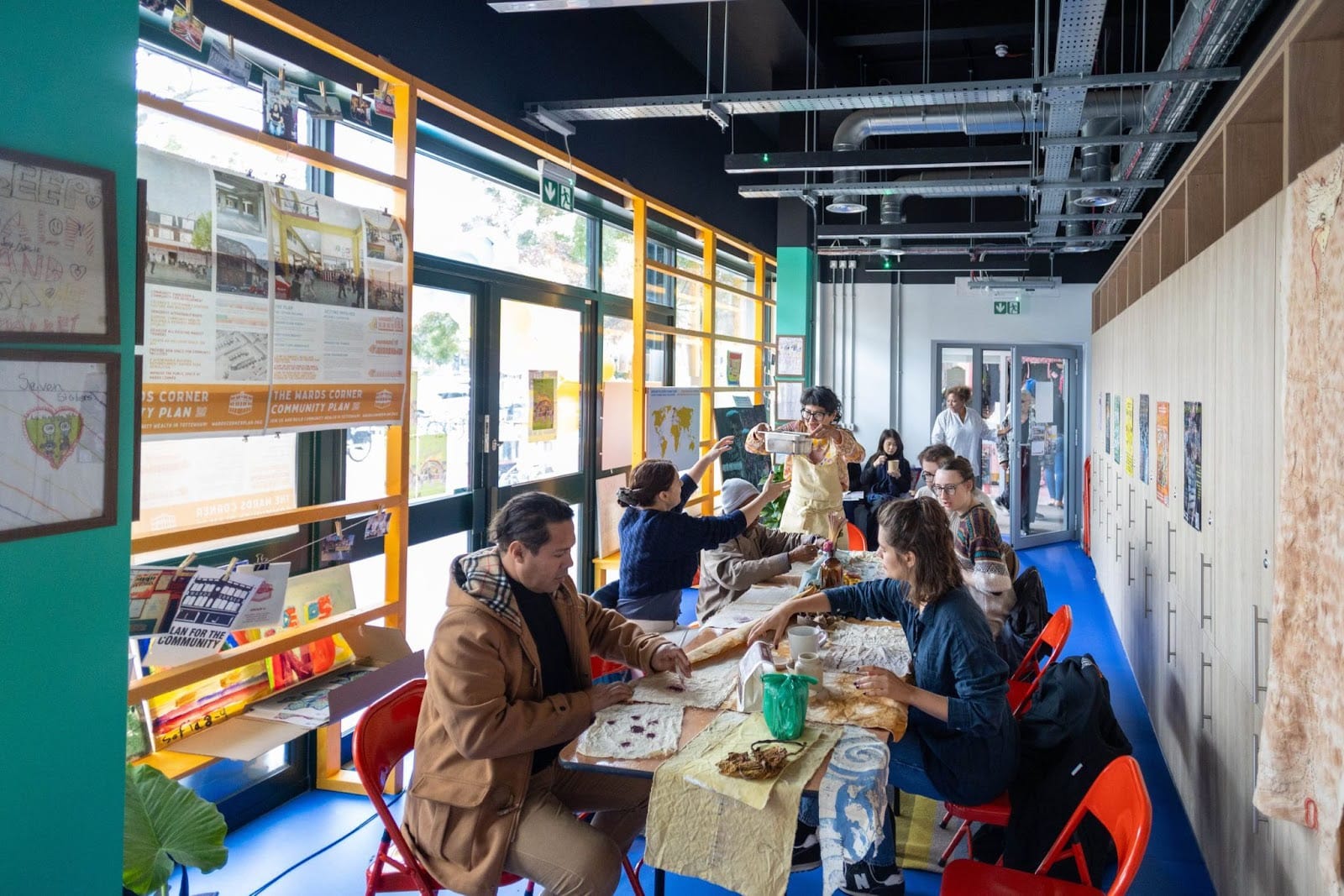Laying the bricks for a better city
How community-led design is forging solidarity across London's urban struggles.

It was the second night of Rosh Hashanah (the Jewish new year) when I was cycling to a friend’s house in Lea Bridge for dinner. As I pedalled up Stamford Hill and shot through the junction with the big Sainsbury’s on the corner, I recalled Oliver Wainwright’s recent reporting for The Guardian on a new housing estate in Clapton Common – Britain’s first example of a council housing project built specifically for the Haredi community. I decided to take a slight detour to look at the new development in the evening light.
Tower Court has been constructed to meet the unique needs of Hackney’s Haredi community, with architects and ‘public realm experts’ working with locals on its design for over a decade. Most units include four or five bedrooms to accommodate their larger families, kitchens are fitted with two separate sinks to ensure kosher food prep, and lifts operate automatically on Shabbat. The estate’s balconies are even staggered to allow residents to celebrate Sukkot (with sukkahs which open directly onto the sky). However, an architect behind the scheme pointed out that the features and additions made to house this community are indeed to anyone’s benefit: “‘A well laid-out bedroom is a well laid-out bedroom, no matter who you are… a view of the sky is nice for everyone, whatever your faith.’”
I cycled up to Tower Court to see the brickworks up close. Wainwright focuses his reporting on the estate’s architectural feats which include bricks arranged in such a way to give off the appearance of old worn cloth. It’s a world of difference to the fake brick facades commonly seen on new-builds in London, infamous for peeling away as quickly as they’re glued on. I circled around the back end of the estate and came across a group of children playing tag. As I turned back onto the main road to continue on to dinner, I saw that several dozen residents were praying around Clapton Pond in the moonlight, casting the sins of the past year into the water to mark the beginning of a new one.
Fighting for, not just against
Haredi Jews are one among many working-class communities centred around this corner of north-east London. They have been hit particularly hard by the government’s cruel adherence to the two-child benefit cap and are struggling through the cost-of-living crisis which makes kosher eating incredibly expensive, given the “disproportionate inflation” of kosher ingredients, on top of large family sizes.
And much like their other working-class neighbours, gentrification has placed an existential threat on their community and way of life. Hackney’s transformation into London’s "borough du jour” has brought about surging house prices and soaring rents, leaving many families with few other options than to decamp from the area entirely. This is partly the reason for the exponentially growing numbers of Haredim bidding farewell to Stamford Hill and embracing Canvey Island, a town on the banks of the Thames Estuary in Essex.
Public works like Tower Court provide a lifeline for working-class residents trying desperately to retain a foothold for themselves and their communities in a ludicrously expensive city. The development has its limitations – only 36 of the 132 new units are for social rent, with the remainder under shared ownership or for private sale. However, Hackney Council has retained control over the land rather than selling it off to the private developer, allowing them and the consulted community greater say over the design. This ensures its social benefit is delivered to those with the greatest need. In this way, the development was configured around the existing community, rather than what is typically the other way around.
The delivery of this housing project demonstrates what is possible when councils respond to the basic needs of their constituents and leverage their power to help communities remain in their established domains. The rigorous consultation process shows how the state’s resources can be effectively mobilised into bolstering a community’s right to self-determination.
Among the clear takeaways from Wainwright’s piece and the development itself is that building according to the particular needs of one community can elevate the living standards for all. This rests a significant lesson about the fight for the future of the city. It shows that the work of resisting gentrification must also entail a battle for urban space – in the form of new housing, community space and infrastructure. This work must accompany the more commonplace struggles against developments which serve the needs of capital rather than the needs of the people.
Coming armed with blueprints
The struggle to stay put in our neighbourhoods is a fight for the use and common ownership of the urban fabric. It’s not nearly enough to cross our fingers and hope that our neighbourhood isn’t the next to come ‘on the up’. It also isn’t enough to focus only on blocking the encroachment of luxury, build-to-rent developments with inane “pet pampering spas”. Those fighting for a more just vision of the city must come armed with blueprints, drawn up by our communities and based on what we require to stay and thrive.
Further inspiration for such a fight lies in the heart of the East End. Since 2020, locals have been fighting relentlessly to block a redevelopment scheme for the Truman Brewery and its surrounding area around Brick Lane. The proposed plans would introduce high-rise office blocks and a data centre into one of London’s most historically important neighbourhoods for the multiracial working class. The area has served for more than 300 years as a refuge for those arriving at its docks, having fled persecution and dispossession around the world. Brick Lane’s social history includes French Huguenots arriving in the 17th century, the Irish escaping the potato famine during the mid-19th century, Jews fleeing the pogroms of Eastern Europe and Russia in the late 19th century and, most recently, in the 70s, Bangladeshi migrants arriving mostly from the Sylhet region.
But what began as a fight against the expansion of infrastructure serving the needs of the City’s financial services sector, has evolved into something much bigger. The Save Brick Lane campaign and organisations like Nijjor Manush, which represent the views and issues facing Bengalis and Bangladeshis in Britain today, channelled the anger and resentment of residents into creating the Brick Lane Masterplan. The plan sets out an alternative vision for the piece of land threatened with gentrification – social and genuinely affordable housing, workspace for small, independent businesses, public squares and green spaces, and a health centre, youth club, library and playgroup.
Without these crucial provisions organised through grassroots-led consultation and design, newer generations of Bangladeshis will continue to be pushed further into the outskirts of London, to places like Rainham and Romford with less cultural diversity and potentially more threats from the rising tide of Islamophobia and ethno-nationalism. Much like the Haredim, Bangladeshis need larger homes to accommodate larger families and intergenerational living. They have also been at the sharp end of public spending cuts and constitute one of the poorest groups in Britain.
Community plans built around the particular requisites of working-class residents – namely housing, jobs, and health and social care – are to the benefit of all who live locally. They are universalist demands which exist across class, racial or ethnic lines. This principle runs counter to the vision and rhetoric of the far-right, which pushes for a ‘blood and soil’ approach of prioritising a racially-defined national body and their control over the land we inhabit. Instead, Tower Court in Clapton and the Brick Lane Masterplan demonstrate that when we attend to those most marginalised in British society, we uplift the living standards and expectations of all.
These case studies also illuminate a roadmap for rebuilding a belief in everyday democracy, where the public bodies we elect value us and deliver materially for us in exchange for our support. In Tower Hamlets, the Labour Party which first approved the monstrous development on Brick Lane in 2021 was booted out the following year, driven by the feeling that the local Labour Party “treat[ed] non-white communities as endless one-way vote banks despite offering little in return”. Tower Hamlets instead elected Lutfur Rahman of the Aspire Party as mayor – a candidate who has staked his political career in breaking away from this paradigm. This is exemplified by his commissioning of the Brick Lane Masterplan and the fact that Aspire Councillors also symbolically rejected the Truman Brewery development plans.
Brick Lane’s fate still hangs in the balance, as a public inquiry into the development recently concluded. The planning application was recalled halfway through the trial and will now ultimately be decided by housing secretary Steve Reed – a factional figure within the Starmer project, as reported by Vashti.
Meeting at Wards Corner
On the first Saturday of October, a jubilant celebration took place in north London to mark the victory of working-class people in exercising their right to the city. The Seven Sisters Market in Tottenham reopened for the first time in over five years – the traders’ previous market had remained shut since the start of the pandemic. The old market was originally called Latin Village due to the presence of a high number of Latin American traders, mostly from Colombia. However, the traders – who are organised by the Community Benefit Society – insisted that their market is one to be enjoyed by all in Tottenham, not only by Britain’s growing Latino communities, and renamed the space Wards Corner on this basis.
Standing in the crowded stalls of the grand opening, I ran into friends and comrades whom I had met through my own involvement in the campaign for the community-led Wards Corner. One mentioned that he knew the spirit of the market had returned when he could hear the salsa music as he came up the stairs of the Seven Sisters underground. Under the overcast skies of autumnal London, I felt a world of possibility as I saw the genuine excitement of people, whether Latino or not, at the thud of Elvis Crespo’s Suavamente over the loudspeakers and the calling out of orders for chicharron and ajiaco.
Good public investment with low barriers to entry, along with community-led planning, can only strengthen London’s best quality – providing the foundation for our ability to meet, encounter and coexist across our vast diversity. There is an incredible bleakness across British politics at the moment – whether it be the draconian crackdown on our right to protest and freedom of speech, the mass outpouring of ethnonationalists at the Unite the Kingdom demonstration, or the infighting which hamstrings the left. Our struggles and victories in London provide an alternate terrain for political hope and expression, where it is possible to build tiny islands of coherence which showcase our collective vision for a better future.▼
To support the legal fees incurred during Brick Lane’s public inquiry, please consider donating here: https://www.crowdjustice.com/case/save-brick-lane-inquiry/
Author
Adam Almeida is a writer who researches housing, gentrification and finance.
Sign up for The Pickle and New, From Vashti.
Stay up to date with Vashti.



